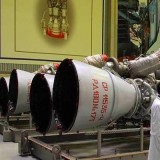Aerix Systems Debuts AXS µ1 Drone that Can Engage Targets From Any Angle Without Repositioning
{loadposition bannertop}
{loadposition sidebarpub}
At the 2025 edition of the SOFINS exhibition dedicated to special forces, Aerix Systems presents a drone system based on omnidirectional propulsion technology, designed to operate in both complex civilian environments and demanding military contexts. This system, named AXS-µ1, builds on technologies developed for the Aerix T-6 platform. It combines high maneuverability with the ability to fly inverted and rotate freely, allowing for stable flight performance even in strong wind conditions.
Follow Army Recognition on Google News at this link
Aerix Systems offers an integration-agnostic platform with 32 mechanical attachment points distributed across the drone (Picture source: Army Recognition)
The AXS-µ1 drone reaches a maximum speed of 200 km/h and has a range of up to 20 kilometers. It offers centimetric precision and sub-degree control across all three axes of motion, including full 360° roll, pitch, and yaw. Wind resistance is rated up to 100 km/h. With a compact footprint (40 cm x 40 cm), it carries a maximum payload of 1.5 kg and operates on battery power for up to 15 minutes. Its design allows for agnostic mission integration without prior configuration, enabling it to adapt to various operational needs.
Aerix Systems offers an integration-agnostic platform with 32 mechanical attachment points distributed across the drone. The electronic interfaces support a wide range of standard communication protocols (USB, UART, I2C, SPI, MIPI/CSI, Ethernet), simplifying integration into existing communication architectures. On the software side, the system provides access to navigation, control, and status parameters, along with the ability to integrate artificial intelligence, computer vision, and onboard mission software. It can be piloted autonomously or via FPV mode, with semi-automated assistance and an AI-based obstacle avoidance system. Its plug-and-play configuration is designed to minimize operator training requirements.
Multiple operational profiles are foreseen for this aerial platform, including use as a short-range loitering munition or a micro-cruise missile capable of performing terminal strike strategies on fixed or mobile targets, including vehicles. It may also be employed for defense against missiles and aircraft, in ISTAR missions (intelligence, surveillance, target acquisition, reconnaissance), or as an armed drone. Its application in counter-UAS scenarios is also considered, with the ability to autonomously intercept hostile drones at any vulnerable point. The system also distinguishes itself through its ability to fly close to the ground with low detectability and navigate autonomously in confined environments.
All development and production of the AXS-µ1 drone, including both the airframe and integrated system, is carried out entirely in Bordeaux. This localized control of the industrial value chain provides Aerix Systems with strategic independence in a context marked by international supply constraints and growing demand for technological sovereignty.
Aerix Systems positions itself as a French specialist in omnidirectional propulsion. Although the brochure displays a British flag, the clear identification of France as the technology’s country of origin suggests a company operating across both markets. With a high-performance onboard computer dedicated to real-time inference tasks, the AXS-µ1 offers a modular solution deployable in various environments, including land, naval, and aerial operations.
The proliferation of this type of vector, marked by its agility, compact size, and adaptability to diverse roles, reflects the rapid evolution of modern warfare. Lightweight and intelligent autonomous platforms like those developed by Aerix Systems contribute to reshaping engagement models, particularly in special operations and urban areas, where responsiveness and discretion are essential.

{loadposition bannertop}
{loadposition sidebarpub}
At the 2025 edition of the SOFINS exhibition dedicated to special forces, Aerix Systems presents a drone system based on omnidirectional propulsion technology, designed to operate in both complex civilian environments and demanding military contexts. This system, named AXS-µ1, builds on technologies developed for the Aerix T-6 platform. It combines high maneuverability with the ability to fly inverted and rotate freely, allowing for stable flight performance even in strong wind conditions.
Aerix Systems offers an integration-agnostic platform with 32 mechanical attachment points distributed across the drone (Picture source: Army Recognition)
The AXS-µ1 drone reaches a maximum speed of 200 km/h and has a range of up to 20 kilometers. It offers centimetric precision and sub-degree control across all three axes of motion, including full 360° roll, pitch, and yaw. Wind resistance is rated up to 100 km/h. With a compact footprint (40 cm x 40 cm), it carries a maximum payload of 1.5 kg and operates on battery power for up to 15 minutes. Its design allows for agnostic mission integration without prior configuration, enabling it to adapt to various operational needs.
Aerix Systems offers an integration-agnostic platform with 32 mechanical attachment points distributed across the drone. The electronic interfaces support a wide range of standard communication protocols (USB, UART, I2C, SPI, MIPI/CSI, Ethernet), simplifying integration into existing communication architectures. On the software side, the system provides access to navigation, control, and status parameters, along with the ability to integrate artificial intelligence, computer vision, and onboard mission software. It can be piloted autonomously or via FPV mode, with semi-automated assistance and an AI-based obstacle avoidance system. Its plug-and-play configuration is designed to minimize operator training requirements.
Multiple operational profiles are foreseen for this aerial platform, including use as a short-range loitering munition or a micro-cruise missile capable of performing terminal strike strategies on fixed or mobile targets, including vehicles. It may also be employed for defense against missiles and aircraft, in ISTAR missions (intelligence, surveillance, target acquisition, reconnaissance), or as an armed drone. Its application in counter-UAS scenarios is also considered, with the ability to autonomously intercept hostile drones at any vulnerable point. The system also distinguishes itself through its ability to fly close to the ground with low detectability and navigate autonomously in confined environments.
All development and production of the AXS-µ1 drone, including both the airframe and integrated system, is carried out entirely in Bordeaux. This localized control of the industrial value chain provides Aerix Systems with strategic independence in a context marked by international supply constraints and growing demand for technological sovereignty.
Aerix Systems positions itself as a French specialist in omnidirectional propulsion. Although the brochure displays a British flag, the clear identification of France as the technology’s country of origin suggests a company operating across both markets. With a high-performance onboard computer dedicated to real-time inference tasks, the AXS-µ1 offers a modular solution deployable in various environments, including land, naval, and aerial operations.
The proliferation of this type of vector, marked by its agility, compact size, and adaptability to diverse roles, reflects the rapid evolution of modern warfare. Lightweight and intelligent autonomous platforms like those developed by Aerix Systems contribute to reshaping engagement models, particularly in special operations and urban areas, where responsiveness and discretion are essential.




